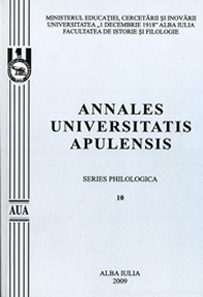ASPIRAŢII ALE UMANITĂŢII ÎN CREAŢII LITERARE ROMÂNEŞTI
HUMANKIND'S ASPIRATIONS AS REFLECTED IN ROMANIAN LITERARY WORKS
Author(s): Maria HolhoșSubject(s): Customs / Folklore
Published by: Universitatea »1 Decembrie 1918« Alba Iulia
Keywords: life; death; aspirations; limits; ideal
Summary/Abstract: In the folklore texts, as well as in the modern culture, there are prolongations of the reality in the ideal world. Our folklore believes , primarily derived from the Romanian fairytales , convey an organic view of the world , a primitive life order because of its simple structures. The primitive spirit inlays towards the concrete, by having the tendency of localizing some abstract notions on the Earth. It is generally conveyed the terrestrial life, the one which people intensely love, although, sometimes , the metaphysic nostalgia comes up. This way, we are faced with a trip in space and time, opposed to the terrestrial life, outlining a transcendental world , as a far away perspective. In the folklore vision, the human is not tempted to have an adventure in an unknown place. In the collective imaginary world, the cosmos is brought closer, and the human tries to influence and humanize it, treating it as a refuge from the great life flusters, or even a support. We can also observe an innovating characteristic of the folklore creations,including continuous soul flusters, with the help of the ethnic thought. Always enriched, the inherited spiritual order hides some signs of a superior lucidity, of an awareness that bypasses the village’s usual level. These opinions frequently go towards the two cosmos verticals, involving the transcendental , making more acceptable the awareness of his ephemeral life on the Earth. In the folklore texts, there are often seen images that suggest the Earth’s deepness- the death ( the darkness) and the Sky’s highness-the holy world, the eternal spirit.Carefully decoding these images, it may seem as a combination between materiality and spirituality . It can also be seen from the text, a desire of rising towards transcendental , an aspiration to knowing the eternal spirit. On searching the answers to those two big humanty flusters – life and death- it implies the human’s aspirations towards bypassing his own condition. The immortality myth presented in one of the most representatives Romanian fairytales entitled “Youth everlasting and life without end” caught the writer Mircea Eliade’s attention, taking up some of the post-war stories that had a marked fiction character (Les trois Grâces and Youth everlasting and life without end ) the idea of eternal youth. In Eliade’s fairytales, as well as in his cultural texts , there are certain inserted symbols that hand towards anthropology and sometimes towards theology. In the cultural texts, the explanation goes towards shaping the consequences of the original sin in what concerns the human body’s evolution. Moreover, by using terms that refer to Biology and Medicine, Mircea Eliade tries to catch le reader’s attention through an analyses scenario of possible changes concerning the human body’s evolution by the intervention of the science
Journal: Annales Universitatis Apulensis. Series Philologica
- Issue Year: 11/2010
- Issue No: 4
- Page Count: 1
- Language: Romanian

